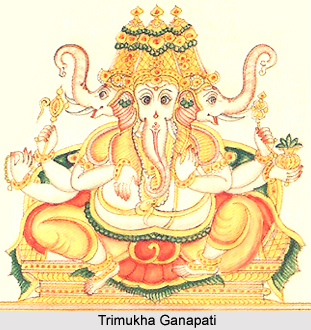 Trimukha Ganapati, meaning the three-faced god, is one of the popular forms of Lord Ganesha. In this form, the elephant headed deity is portrayed in red complexion. He is seated in the centre of a golden lotus throne. Trimukha Ganapati has six arms. The main right hand displays the Abhaya Mudra and the main left hand is shown in the Varada Mudra posture. In the rest of his hands Lord Ganesha carries prayer beads, a noose, a goad and a golden Kamandalu (pot for storing holy water).
Trimukha Ganapati, meaning the three-faced god, is one of the popular forms of Lord Ganesha. In this form, the elephant headed deity is portrayed in red complexion. He is seated in the centre of a golden lotus throne. Trimukha Ganapati has six arms. The main right hand displays the Abhaya Mudra and the main left hand is shown in the Varada Mudra posture. In the rest of his hands Lord Ganesha carries prayer beads, a noose, a goad and a golden Kamandalu (pot for storing holy water).
The Trimukha Ganapati form of Lord Ganesha is worshipped by the recitation of a devotional hymn known as the Trimukha Ganapati Mantra. The worshippers who pray and revere this deity attain salvation or Moksha. Moreover, the devotees seeking penance for past sins also worship Lord Trimukha Ganapati. Meditation on Trimukha Ganapati aids in removing the fear of future.
The Trimukha Ganapati Mantra can be recited as follows-
Srimattikshana Shikankushaksha
Vardaan Dakshe Dadhaanah Karah.
Paasham Chamrita Poornakumbhamabhaye
Vaame Dadhaano Mudhaa.
Pethe Swarnamayaravinda
Vilasata Satkarnikaa Bhasure.
Swaasinah Trimukhah Palaas
Ruchiro Naagaasana Paatu Nah.
This article is a stub. You may enrich it by adding more information to it. You can send your write-up at content@indianetzone.com




















